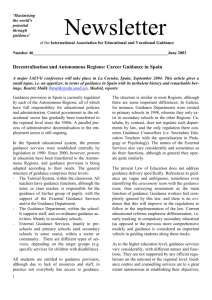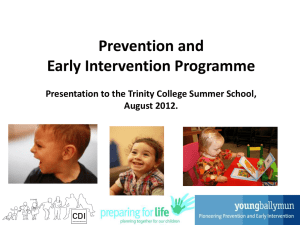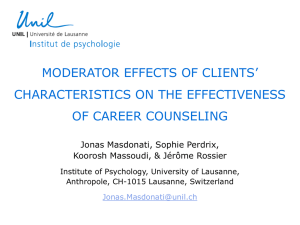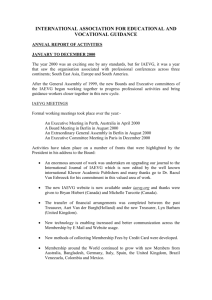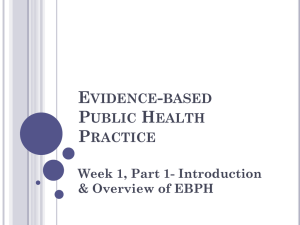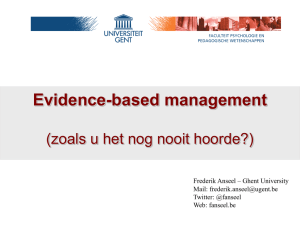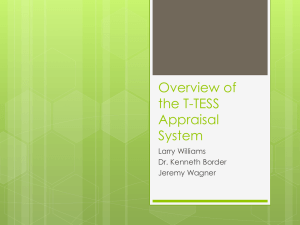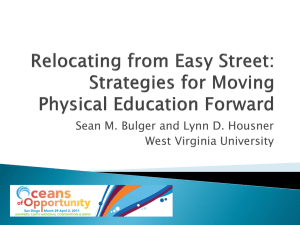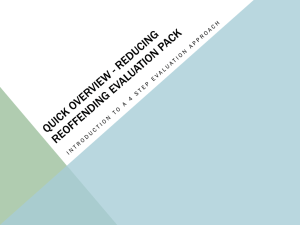Outcome
advertisement
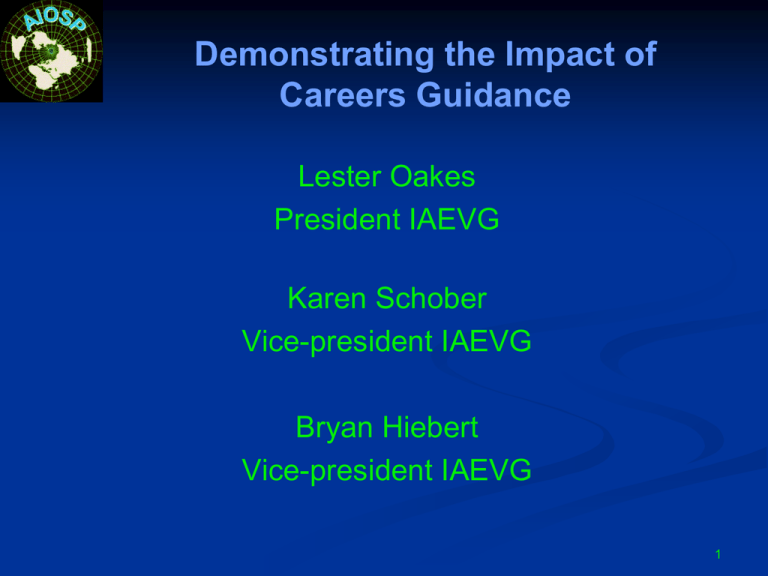
Demonstrating the Impact of Careers Guidance Lester Oakes President IAEVG Karen Schober Vice-president IAEVG Bryan Hiebert Vice-president IAEVG 1 A Challenge from Policy Makers You say you are providing effective services We believe you BUT Show us the evidence 2 Policy-Practice-Research Dialogue 1. 1999: First International Symposium on Career Development and Public Policy 2. Establishment of International Centre for Career Development and Public Policy • IAEVG has been an active supporter of the International Centre 3. International symposiums held in Canada, Australia, Scotland, New Zealand 4. 2009: Sixth International Symposium on Career Development and Public Policy 5. Predominating theme was Prove it Works 3 Overview IAEVG has been an active participant in past symposiums and outcome-focused, evidencebased, practice has been an important part of IAEVG strategic planning • Update from European Lifelong Guidance Policy Network • Update from Canadian Research working Group on Evidence-based Practice in Career Development 4 Karen Schober will update us on what is happening in the European Lifelong Guidance Policy Network 5 Outcome Focused Evidence-Based Practice Input Process Outcome Framework developed by the Canadian Research Working Group on Evidence-Based Practice in Career Development 6 Outcome-Focused Evidence-Based Practice Input Process Outcome Indicators of client change 1.Learning outcomes • Knowledge and skills linked to intervention 2.Personal attribute outcomes • Changes in attitudes, • Intrapersonal variables (self-esteem, motivation, independence) 3.Impact outcomes • Impact of #1 & #2 on client’s life, e.g., employment status, enrolled in training • Societal and relational impact • Economic impact 7 Outcome-Focused Evidence-Based Practice Input Process Outcome Activities that link to outputs or deliverables Generic interventions • Working alliance, microskills, etc. Specific interventions 1. Interventions used by service providers • Skills used by service providers • Home practice completed by clients 2. Programs offered by agency 3. Involvement by 3rd parties 8 Evidence-based Outcome-focused Practice Input Process Outcome Resources available 1. Staff • Number of staff, level of training, type of training 2. Funding • Budget 3. Service guidelines • Agency mandate 4. Facilities 5. Infrastructure 6. Community resources 9 Outcome-Focused Evidence-Based Practice Input Process Outcome Intervention = Process + Outcome What will I do? + How is it working? Professional Practitioner 10 Evidence-based Practice 1. Research trials (traditional way in psychology) 2. Professional Practitioner • Purposeful intervention • Data (= evidence) on what was done • Evidence on client change • Look for patterns in data linking intervention with outcome • Develop scientific attitude toward practice Skepticism Curiosity Inquiry 11 Intervention Planning & Intervention Evaluation Intervention Planning Framework Context: Client Needs 1 Client Outcomes Client Counsellor Client • Knowledge Goals Strategy Strategy • Skills • Attributes • Impact 3 2 12 12 Intervention Planning & Intervention Evaluation Intervention Planning Framework Context: Client Needs Client Outcomes Client Counsellor Client • Knowledge Goals Strategy Strategy • Skills • Attributes • Impact Intervention Evaluation Framework Inputs Processes Outcomes 13 Quality of Service Delivery 1. Accessibility • • • • • 2. Regular hours Extended hours Physical accessibility Resources in alternate format Ease of access, who can access Timeliness • • • 3. Responsiveness • • • Respect from staff Courteous service Clear communication 4. Overall satisfaction • • % rating service good or excellent % referrals from other clients % calls answered by 3rd ring Wait time for appointment Wait time in waiting room Need to negotiate these with funders 14 Comprehensive Service Evaluation Quality Service framework Service delivery Client volumes Client presenting problems Number of sessions Service standards Staff credentials, competencies, resources Efficiency (at client needs being met?) System requirements Adherence to mandate Completion of paper work Cost-effectiveness 15 Negotiated outcomes If you are lucky, funders might identify personal attributes [client motivation, improved job satisfaction, increased self-confidence] or knowledge, or skills, as accountability indicators BUT more likely funders will identify impact outcomes [employment status, enrolment in training, reduced # of sick days, increased productivity, etc.] or inputs [client flow, accessibility, timeliness of paper work, etc.] So service providers need to identify the knowledge, skills, personal attributes that will produce the impacts and negotiate these as accountability indicators Be careful what you promise to deliver BUT deliver what you promise Promise small – DELIVER BIG 16 Assessment as Decision Making (vs. Judgement) Please use a two-step process 1. Would you say that your level of mastery of the attribute under considerations is unacceptable 00 1 acceptable 2 3 44 1. Then assign the appropriate rating 0 = really quite poor 1 = just about OK, but not quite 2 = OK, but just barely 4 = really very good 3 = in between barely OK and really good 17 Problem with skill self-assessment Participants asked to rate their skill (or knowledge) before and after a program Often, pre-workshop scores are high and post-workshop scores are lower • People find out as a result of the workshop that they knew less than they thought or had less skill than they thought • Based on the new awareness, post-scores are lower People don’t know what they don’t know How can we get around this problem? Assessing Learning & Attribute Outcomes Post-Pre Assessment We would like you to compare yourself now and before the workshop. Knowing what you know now, how would you rate yourself before the workshop, and how would you rate yourself now? Please use a two-step process: • Decide whether the characteristic in question is acceptable or unacceptable, then • assign the appropriate rating unacceptable 00 1 acceptable 2 3 44 19 CRWG: Ongoing Projects 1. Validate framework and approach • ACT evaluation 2. Field test interventions • Develop evaluation component as part of intervention • SME project 3. Field tests of practitioner use • LMI project 4. On the horizon 20 Applied Career Transitions Program Module 1 Building Career Foundations Module 2 Developing Career Opportunities Module 3 Getting Experience: The Internship • On-line Program Curriculum • Program Access Options On-line only Coached (four coaching appointments per module) Coached with In-class Group Sessions (four coaching appointments and four group sessions per module) 21 Results: Post-Pre Assessment For Module 1 • • • • • All together there were10 (items) x 29 (participants) = 290 ratings Pre: 144 Unacceptable Ratings and 6 Exceptional Ratings Post: 3 Unacceptable Ratings and 130 Exceptional Ratings Exceptional Ratings increased from 2 to 44% of the participants Pre: 50% Unacceptable Ratings; Post: 86% Acceptable Ratings 22 Results: Impact outcomes Module 1 • 23 out of 29 had found a job • 10 of the jobs lined up well with career vision Module 2 • 4 out of 6 had found a job • 3 of the jobs lined up well with career vision 23 Attribution for Change To what extent would you say that the changes depicted above were the result of completing Module 1 of the ACT program, and to what extent were they a function of other factors in your life? mostly other factors somewhat other factors 0 0 uncertain 0 somewhat mostly this this program program 10 19 24 WSI Project Career Development in SMEs Career Development interventions for Small and Medium Enterprises to promote personal ownership for career planning and within-organization career mobility Three types of intervention Minimal: Web-based self-help intervention Moderate: On-the-job career conversations with managers, supervisors, colleagues Intensive: Bilan des competences 25 WSI Project General approach 1. Literature review • What is know already about the three areas of intervention 2. Formal needs assessment 3. Design intervention AND evaluation plan 4. Field test intervention 5. Consolidate evaluation evidence 6. Final report 7. Market results 26 WSI Project General results 1. All 3 interventions worked 2. Different programs • designed for different purposes • requiring different resources • Chose the approach that best meets organizational needs 3. It’s better to do something than nothing 27 Practitioner Field Tests 1. Use and impact of Labour Market Information (LMI) • Isolate LMI from other interventions 2. Participant research approach • Normal clients seeking service • Agencies offering services 3. Use Post-Pre approach 28 Research Design Intervention Job Search CDM Time 2 Time 1 Delivery 29 LMI: General Results 1. All intervention-delivery combinations produced significant change • • • • General ability to access and use LMI Knowledge about how to use LMI Skills for using LMI and taking action Personal attributes, e.g., optimism, confidence 2. Assisted use produced greater change across time than independent use 3. 80% of clients attribute change to the program and not other factors 30 On the Horizon Common Indicators Project 1. Identify 3-5 indicators of success that all agencies will collect • Focus groups to identify outcomes and data source 2. Aggregate results across agencies 3. Increase power of results 31 Resources Available • Major report on evaluation practices • Special issue of Canadian Journal of Counselling • Sample tools and data gathering instruments • Evaluation workbook • Presentation notes, power point slides, etc. • Survey/needs assessment for self-help intervention http://www.crwg-gdrc.ca 32 To demonstrate value, we need to develop Culture of evaluation: We need to reach the state where • Identification of outcomes is an integrated part of providing services Without efficacy data, career services are vulnerable It is in our best interest to gather evidence attesting to the value of the services we provide • Measuring and reporting outcomes is integrated into practice • Outcome assessment is a prominent part of counsellor education • Reporting outcomes is a policy priority This needs to be a priority in all sectors 33 Demonstrating the Impact of Careers Guidance Questions and Comments Lester Oakes President IAEVG Karen Schober Vice-president IAEVG Bryan Hiebert Vice-president IAEVG membership@iaevg.org 34
